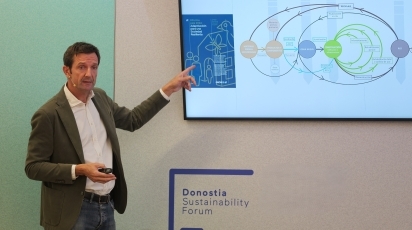Architecture for Tomorrow: Towards a Sustainable Reality
Building and urban planning are at a crossroads in a global crisis and which requires their model to be totally overhauled, as the architect Bruno Sauer, CEO of Green Building Council España (GBCE), explained during a talk at the Donostia Sustainability Forum; when he analysed the role that sustainable architecture must play as a driver for change in the face of the social and environmental challenges.

During this lecture, organised by the Basque-Navarre Institute of Architects in Gipuzkoa (COAVN), Sauer called for a paradigm shift based on sufficiency, efficiency and the circularity of materials to address the pressing global risks facing the construction sector.
As Bruno Sauer explained, construction is responsible for roughly 50% of resources extracted and consumed annually, over 30% of the total waste, nearly 40% of the EU’s energy consumption and 36% of energy-related greenhouse gas emissions. Therefore, he added, the architecture of the future must lower its environmental footprint, by fostering the decarbonisation of the economy while facing risks such as the loss of biodiversity.
Sauer stressed the key concept of sufficiency in that regard: planning the minimum necessary to maintain people’s comfort, development and wellbeing. Sufficiency emerges as a pressing need as the result of overconsumption. Societies such as Spain’s currently consume the equivalent of 2.5 Earths a year, which is over what is considered acceptable to remain within the planet’s limits. Developing a truly functioning circular economy is particularly important as regards sufficiency.
The Circular Economy Challenge and the ‘Urban Quarry’
The great challenge for the circular economy to be applied to architecture is to cut the use materials by a quarter. In architecture, that implies designing buildings using materials from recycling rather than from virgin extraction.
Sauer raised an inconvenient but necessary point: it is not worth refurbishing all buildings with defects. When their materials reach the end of their service life or have serious pathologies, such obsolete buildings should be considered as ‘raw material quarries’ for a new repair industry. This perspective comes from the need to accept the ‘demolition’ of buildings that cannot be refurbished in order for circularity to advance, as that currently the amount of recycled material in the sector in Spain is a ‘pittance’.
The Architecture of Tomorrow
Sustainable architecture of the future is not necessarily strange, but rather ‘very normal architecture, but with several very important changes’. Thus, the speaker stressed design sufficiency, with the use of exposed bricks and facilities, without false ceilings and with passive solar protection to ensure comfort without air conditioning.
In the field of biomaterials, Sauer highlighted the use of wood, of terracotta bricks that control the temperature by absorbing and expelling humidity, and industrialised compacted earth. He went on to explain that glass – despite being easy to recycle – poses problems to do with obtaining silica, and that its widespread use on standardised façades is an urban planning and energy error.
Sauer explained that the great architecture and urban planning errors so far include standardised architecture – building in the same way in New York as in China –, architecture serving industry, not recognising that resources are finite and car-oriented urban planning.
Conversely, the principles for success – in his opinion – are a breathing architecture, the use of recovered and local materials, multimodal mobility, ensuring the car is at the same level as the pedestrian and cyclist, and the emphasis on long-term and adaptable buildings.
Obstacles to overcome
The European Union has set the target for housing stock to be decarbonised by 2050, which Sauer considers to be possible, but hard to achieve. Overregulation is one of the obstacles that he highlighted. Even though the current Technical Code does not prohibit passive architecture, it makes it almost impossible to implement without very advanced knowledge. As regards urban planning, sustainability is a process that must be planned in 20-, 30- or 50-year periods, which clashes with policy, which works in 4- to 8-year cycles.
He also pointed out that polluting is cheaper than non-polluting architecture. He stressed that regulatory mechanisms – such as higher taxes, regarding toxic materials and the use of non-sustainable buildings – are needed to tackle this situation.
In his opinion, the current lifestyle is no longer ‘temporarily out of stock’, but rather is ‘no longer in stock once and for all’. The change is not a debate about materiality or design, but rather about responsibility and attitude. The future of the cities, he added, requires a great transformation.



